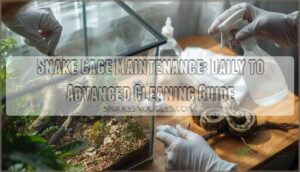This site is supported by our readers. We may earn a commission, at no cost to you, if you purchase through links.

Bacterial infections usually need vet-prescribed antibiotics, while fungal cases call for antifungal medication.
For parasites, antiparasitic drugs like ivermectin may be required.
Support your snake with a clean, warm, and stress-free environment, as this boosts recovery and prevents further complications.
Watch for symptoms like wheezing or open-mouth breathing and act fast—waiting too long is like letting weeds ruin a garden.
In severe cases, intensive care, including fluid therapy and nebulization, can save the day.
Proper care and prevention go hand-in-hand to keep your snake healthy!
Table Of Contents
- Key Takeaways
- Snake Respiratory Infection
- Diagnosing Respiratory Issues
- Treatment Options Available
- Preventing Respiratory Infections
- Managing Respiratory Infections
- Frequently Asked Questions (FAQs)
- How do you treat a snake infection?
- How do you treat a respiratory infection in a reptile?
- How is interstitial pneumonia treated in snakes?
- What antimicrobials do snakes need?
- How do you treat a ball python respiratory infection?
- How to treat a respiratory infection in a snake?
- What is the best remedy for respiratory infection?
- What does a respiratory infection look like on a snake?
- What antibiotic for ball python respiratory infection?
- Can respiratory infections spread to humans?
- Conclusion
Key Takeaways
- Act quickly if you notice symptoms like wheezing or open-mouth breathing; consult a vet for antibiotics, antifungals, or nebulization therapy.
- Keep your snake’s enclosure clean, warm, and at the right humidity levels to prevent infections and support recovery.
- Reduce handling stress and provide proper nutrition and hydration to boost your snake’s immune system.
- Schedule regular veterinary check-ups to catch potential issues early and ensure tailored care for your snake’s health.
Snake Respiratory Infection
Respiratory infections in snakes can quickly become serious, impacting their breathing and overall health. Understanding the causes, symptoms, and treatments helps you take swift action to protect your pet.
Bacterial Infections
Bacterial infections in snakes often creep in through poor hygiene or stress, causing respiratory issues like snake pneumonia.
Infection control starts with keen observation and timely action.
Here’s what helps:
- Spot symptoms early—like wheezing or nasal discharge.
- Prioritize microbial management—keep habitats clean.
- Use antibiotic treatment guided by a vet for effective snake respiratory care.
Viral Infections
Viral infections like paramyxovirus can wreak havoc on a snake’s respiratory system.
Watch for respiratory symptoms such as open-mouth breathing and lethargy.
Virus transmission happens via shared enclosures or contaminated surfaces.
Prevention and infection control matter—consider quarantining new snakes and exploring potential snake vaccines.
Understanding viral infection symptoms is essential for effective treatment and prevention of respiratory issues in snakes.
| Viral Strains | Symptoms | Spread Methods |
|---|---|---|
| Paramyxovirus | Wheezing, pneumonia | Close contact |
| Nidovirus | Nasal discharge, lethargy | Contaminated items |
| Inclusion Body Virus | Weight loss, labored breathing | Direct exposure |
Fungal Infections
Two deadly respiratory fungi, including Aspergillus, can strike your snake’s lungs when fungal spores invade.
Snake fungus often emerges when your pet’s immune system can’t fight off these microscopic invaders.
Here’s what you’ll face:
- White patches forming in your snake’s mouth
- Labored breathing that worsens daily
- Refusal to eat as the infection progresses
- Lethargy that signals the need for antifungal medications
Understanding fungal infection causes is essential for effective treatment and prevention of such diseases in snakes.
Parasitic Infections
Internal parasites can wreak havoc on your snake’s respiratory system.
Roundworms and coccidia are common culprits that affect breathing by migrating through the lungs.
Watch for labored breathing, weight loss, and unusual discharge.
Your vet might prescribe antiparasitic drugs like ivermectin to tackle these invaders.
Regular parasite control checks and proper hygiene help prevent crypto and other parasitic infections from taking hold.
Diagnosing Respiratory Issues
Looking out for snake infection symptoms can feel like being a reptile detective, but spotting the signs early makes all the difference.
Your vet will need a detailed history of your snake’s care routine for accurate symptom analysis.
Larger snake species like boas and pythons are particularly susceptible to these infections, according to this snake respiratory disease guide.
During respiratory tests, they’ll examine signs of respiratory distress like nasal discharge and unusual breathing sounds.
Medical imaging, particularly X-rays, reveals potential lung tissue issues, while lab results from blood work and fecal samples help identify underlying problems.
Diagnostic tools like CT scans might be necessary for complex cases.
Watch for key respiratory infection symptoms: increased breathing effort, open-mouth breathing (like an opera singer), watery discharge from eyes and nose, and decreased appetite.
Regular health monitoring helps catch snake respiratory infection signs before they become serious complications.
Treatment Options Available
You’ll find several effective treatment options for your snake’s respiratory infection, from antibiotics and anti-inflammatory medications to supportive care methods.
Your veterinarian can create a personalized treatment plan that combines these approaches with proper environmental adjustments to help your snake recover quickly with supportive care.
Antibiotic Therapies
Treating snake infections with prescription antibiotics requires precision.
Always follow veterinary advice for dose administration to guarantee bacterial sensitivity is addressed without risking antibiotic resistance.
Key details to keep in mind:
- Treatment duration matters—don’t stop early, even if symptoms improve.
- Medication interactions can impact effectiveness.
- Snake antibiotics like Enrofloxacin or Ciprofloxacin are common but must be administered carefully.
The use of snake antibiotics is vital in preventing the development of resistant bacterial strains.
Anti-Inflammatory Medications
Anti-inflammatory medications play a pivotal role in treating snake respiratory infections by easing inflammation and supporting antibiotics.
These medications, including steroid therapy options, help with inflammation reduction and pain management.
Careful dosage control is essential to minimize medication side effects.
Always consult a vet to tailor treatment for snake respiratory disease and guarantee the respiratory infection cure aligns with your snake’s needs, using steroid therapy options for inflammation reduction.
Supportive Care Methods
Supportive care is your snake’s lifeline during respiratory infections.
Fluid therapy rehydrates, while heat support bolsters immunity.
If breathing struggles persist, oxygen therapy and nebulization therapy can help clear mucus.
Wrap it up with proper nutrition planning to strengthen recovery.
Tip: Humidity control matters—don’t overlook it!
Keep their environment cozy and stress-free for better healing.
Environmental Adjustments
Your snake’s health thrives on precise environmental adjustments.
Dial in humidity control and temperature gradients to mimic their natural habitat—dry air or extreme heat can spell trouble.
Keep air quality fresh with proper ventilation systems, and design the habitat for ideal temperature regulation, which is crucial for preventing respiratory infections.
Regular enclosure hygiene prevents issues from spiraling, and achieving perfect humidity levels is key, think Goldilocks—just right.
Creating an essential tropical snake environment is vital for the overall health of your snake, ensuring a tropical snake environment that supports their well-being.
Preventing Respiratory Infections
You can prevent respiratory infections in snakes by maintaining a clean habitat, controlling humidity and temperature, and providing proper nutrition.
Regular check-ups with a veterinarian and minimizing handling stress also play key roles in keeping your snake healthy.
Proper Enclosure Hygiene
Keeping a clean habitat isn’t just for looks—it’s your snake’s first defense against respiratory troubles.
Stick to these basics:
- Use proper cleaning supplies: Remove waste and disinfect weekly with reptile-safe products.
- Control humidity levels: Aim for 50-70% using hygrometers.
- Ensure ventilation systems work: Prevent bacteria buildup through airflow.
Regular maintenance involves using the right reptile cleaning supplies to prevent the spread of disease.
Smart husbandry practices prevent infections before they start.
Regular Veterinary Check-Ups
After keeping the enclosure spotless, don’t skip regular veterinary check-ups for your snake.
A reptile veterinarian isn’t just a healthcare provider—they’re your partner in preventive measures.
Routine visits and snake health checks uncover hidden problems early.
Veterinary guidance guarantees accurate medical histories and timely veterinary treatment, think of these inspections as tune-ups, keeping your scaly buddy in peak condition for years to come, with the overall goal of maintaining your snake’s health through regular veterinary check-ups.
Balanced Diet and Hydration
After frequent vet visits, don’t overlook proper nutrition and hydration, as these keep your snake’s immune system in top shape.
Focus on:
- Food variety: Rotate prey types for balanced nutrient intake.
- Water quality: Clean and refill regularly.
- Hydration methods: Mist or soak if needed.
- Nutritional support: Add dietary supplements.
- Portion size: Opt for smaller meals to prevent stress.
Proper snake care also involves understanding snake hydration supplements to guarantee your pet is getting the right amount of nutrients and water.
Minimizing Handling Stress
Stress-free handling is key to keeping your snake healthy.
After ensuring proper nutrition, focus on stress reduction by limiting interactions to necessary ones.
Gentle handling techniques, like slow movements and supporting their body, help with relaxation.
Avoid sudden grabs or excessive handling; snakes need calm environments for stress management.
Always prioritize your snake’s comfort over curiosity for effective stress reduction and overall well-being.
Managing Respiratory Infections
When managing snake respiratory infections, you need to act quickly and focus on specialized care.
Isolate the snake, monitor symptoms daily, and follow your vet’s advice for treatments like nebulization or medication.
Monitoring Health Changes
Spotting a snake respiratory infection early? That’s half the battle.
Watch closely for respiratory symptoms like nasal discharge or wheezing.
Daily observations matter—track even slight changes in behavior or appetite.
Use this checklist:
- Note open-mouth breathing.
- Check for unusual lethargy.
- Log feeding irregularities.
- Watch for abnormal Snake Behavior.
- Document respiratory distress for your vet.
Stay vigilant!
Isolating Infected Snakes
If your snake shows signs of respiratory problems, isolation is key.
Create a separate enclosure and follow strict quarantine protocols to prevent disease transmission.
Clean tools between uses and avoid cross-contamination.
Snake isolation supports biosecurity measures, protecting reptile health care.
Think of it as their personal "hospital room"—a safe zone to recover while controlling infection spread effectively.
Nebulization Therapy Benefits
How does nebulization therapy make respiratory relief easier? It’s a game-changer in snake respiratory care, delivering medications directly into the lungs through inhalation therapy.
Early detection is vital, so promptly consult resources like this guide on treating snake respiratory infections for the best care.
Treating pneumonia or fungal infections becomes more effective, especially since therapy sessions require minimal handling, reducing stress. Plus, maintaining humidity control supports breathing ease, making it a go-to solution for respiratory disease treatment in snakes.
Customized Treatment Plans
Every snake respiratory infection is unique, so treatment protocols should be customized.
With veterinary guidance, you’ll get a plan that’s as personalized as your snake’s scales.
Customized treatment plans often include:
- Targeted therapies like antibiotic treatment or anti-fungal medications.
- Supportive care, such as heat and hydration.
- Environmental tweaks to optimize humidity and temperature.
- Ongoing disease management through regular check-ups.
Keep it personal, and they’ll thrive.
Frequently Asked Questions (FAQs)
How do you treat a snake infection?
Ever wondered why your snake seems off?
Treat respiratory infections by consulting a vet, administering prescribed antibiotics, adjusting humidity, and maintaining a clean enclosure.
Support recovery with proper nutrition, hydration, and minimal handling stress, which is crucial for the overall health of your snake and can help with recovery.
How do you treat a respiratory infection in a reptile?
Keep your reptile’s habitat clean, warm, and properly humid.
If you spot wheezing or mucus, get a vet’s help fast.
Treatment may involve antibiotics or nebulization, so don’t delay—early care makes all the difference.
How is interstitial pneumonia treated in snakes?
You’ll treat interstitial pneumonia in snakes with antibiotics suited to the infection, supportive care like warmth and hydration, and sometimes nebulization to ease breathing.
Work closely with a vet to guarantee proper diagnosis and recovery.
What antimicrobials do snakes need?
Snakes need targeted antimicrobials like antibiotics for bacterial infections (e.g., enrofloxacin, ceftazidime) or antifungals (e.g., itraconazole).
Your vet tailors treatments based on diagnostics, so don’t guess—only a pro knows what’s best!
How do you treat a ball python respiratory infection?
When your ball python’s under the weather, a vet visit is your first move.
They’ll diagnose and prescribe treatments like antibiotics or nebulization.
Adjust its habitat—perfect humidity and warmth boost recovery while minimizing stress.
How to treat a respiratory infection in a snake?
Watch for open-mouth breathing, wheezing, or mucus buildup.
Take your snake to a vet for antibiotics or antifungals.
Boost humidity, keep enclosure clean, and reduce stress, which can be considered early care that can save your scaly friend’s life!
What is the best remedy for respiratory infection?
When your snake’s sneezing sounds like a tiny trumpet, the best remedy is prompt vet care.
Combine antibiotics, customized humidity adjustments, and supportive therapies like nebulization to boost healing.
Early action saves slithering companions!
What does a respiratory infection look like on a snake?
You’ll notice wheezing, open-mouth breathing, or mucus dripping from their nose or mouth.
Their energy might tank, and they could skip meals.
If they seem more sluggish than usual, it’s worth checking things out.
What antibiotic for ball python respiratory infection?
When battling a ball python’s respiratory infection, veterinarians often prescribe antibiotics like ceftazidime or enrofloxacin, suited to the infection.
Always let a vet guide treatment—guessing with meds is like rolling the dice.
Can respiratory infections spread to humans?
Yes, some snake respiratory infections can spread to humans, especially certain bacterial or fungal diseases.
These zoonotic risks highlight the importance of practicing good hygiene, like washing your hands after handling snakes or cleaning enclosures, to prevent the spread of bacterial diseases.
Conclusion
Swift steps and smart strategies guarantee your snake stays safe from respiratory infections.
Treating common snake respiratory infections means acting quickly with proper diagnosis, prescribed medications, and supportive care.
Keep their environment clean, warm, and stress-free to promote healing and prevent recurrence.
Regular vet visits, balanced nutrition, and reduced handling stress further protect their health.
By staying vigilant and proactive, you’re giving your snake the best chance at a long, happy, and infection-free life.
- https://vcahospitals.com/know-your-pet/snakes-diseases
- https://www.petmd.com/reptile/conditions/respiratory/respiratory-infections-reptiles
- https://reptifiles.com/ball-python-care-guide/ball-python-diseases-health/ball-python-respiratory-infection/
- https://serpentsuppers.com/snake-respiratory-infection/
- https://www.usgs.gov/centers/nwhc/science/snake-fungal-disease













